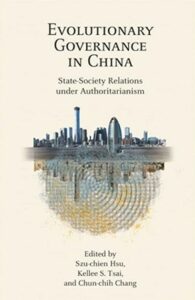
Contemporary China is a rich context for social scientists developing new theories. A leading theme among these explorations is how the ruling elites cope with contending imperatives including fostering economic growth, minimising social conflicts, securing mass loyalty, and yet maintaining their monopoly of political power.
In place of constructing of static regime typologies or narrowly focusing on elite behaviors, Evolutionary Governance in China foregrounds evolving state-society relations and contends that both state and society actors deploy a plethora of strategies, both assertive and accommodative, and are mutually shaped by the interaction. With three theoretical chapters (two introductions and one epilogue) and eleven case studies, this edited volume offers a solid political sociology of the engagement of political power and social forces across subject matter including the environment and health, industrial relations, gender, and religions.
Kellee Tsai offers a magisterial literature survey, including more than 20 ‘authoritarianisms with adjectives (such as resilient, consultative, adaptive, and so on)’, and stresses the regime’s flexible approach as the key to state-society co-evolution. Szu-chien Hsu and Chun-chih Chang’s meta-analysis documents the rich variety of state-and-society interactions and finds that the party-state pragmatically responds to emerging social concerns to still ‘maintain a tight grip on political power’. This adaptive approach allows the regime to steadily improve its policy outputs while minimising political risk.
The communist incumbents adopt an instrumental attitude toward civil society in that independent organisations and activities are tolerated if they are helpful in solving problems. For instance, Beijing homeowner activists are consulted during the drafting of property management laws (Yousun Chang’s chapter), and with the collaboration with community activists, some forms of ‘participatory planning’ are practiced (Hsu and Muyi Chou’s chapter).
A closed system like political dictatorship finds it difficult to innovate its governance from within, and hence, selective incorporation of NGOs and advocacy groups provides the necessary impetus for reforms. But once government leaders no longer feel the need to listen to outsiders, their tolerance quickly vanishes. Chanhsi Wang shows that the government has been willing to collaborate with AIDS-related NGOs because they are the conduits of international donations, but once there is indigenous money and know-how, the latter’s space is greatly proscribed. Analysing the result of anti-incinerator movements, Hsu and Chin-chih Wang find that local officials are willing to adopt opponents’ suggestions to sorting and recycling for waste reduction without abandoning the incinerator project. In terms of industrial relations, after the government institutionalises a system of labor dispute mediation and arbitration, it no longer countenances the presence of labor NGOs (Christina Chen’s chapter). Weiting Wu traces the development of the Chinese women’s movement and how they manage to promote an anti-domestic violence agenda with the partnership with official agencies. Her chapter throws into sharp relief such irony: 2015 saw the arrest of five feminists on the eve of the International Women’s Day (because they were suspected to launch a protest against sexual harassment) as well as the landmark legislation against domestic violence. The above cases highlight the fact that the regime willingness to engage with these new social forces and its tolerance is limited and conditional as best, even though these health environmental, labor, and gender activists possess valuable resources in the form of knowledge and international connections not held by bureaucrats.
When it comes to those social forces that stand in the way of government priorities and that do not obtain the necessary leverage to encourage the officials to come to the negotiation table, outright repression is the typical response from the government. Village leaders who opposed rural land requisition for developmental purposes are often harassed and arrested (Yi-chun Tao’s chapter). Ke-hsien Huang reveals that the tenacious presence of Chinese Christians does not sit well with the emerging official narrative to cast China in terms of a Confucian nationalism. As the top-down effort to ‘sincise’ Christianity makes little progress, authorities’ removal of Christian crosses and church demolition becomes the main strategy to handle this religion regarded as foreign. The Mazu cult appears to be the polar opposite to the persecuted Christianity. Its Chinese origin makes it easier to be absorbed into a China-centered cultural narrative. Ming-chun Ku’s study reveals how the collaboration among local officials and clan leaders help Mazu beliefs to be listed as the UNESCO world’s intangible cultural heritage.
In contrast, foreign companies often possess the technologies that the Chinese government needs for economic modernisation. In encouraging their investment, government officials struggle to meet other goals such as labor protection and industrial upgrading toward higher value-added production. Chih-peng Cheng’s chapter on Yue Yuen (the maker of Nike shoes) and Thung-Hong Lin’s chapter on Foxconn (the maker of iPhones) offer insight into the dilemmas of the government when major labor disputes took place. Such businesses sometimes respond with better worker payment and compensation, but they may also relocate their production to China’s inland provinces or other countries with lower wage costs.
Evolutionary governance entails state actors alternating between coercion and collaboration in responding to new challenges—the secret recipe for the resilience of Chinese authoritarianism. However, since Xi Jinping took office a decade ago, the relentless drive for central power concentration, ideological orthodoxy, and rejection of Western values has restricted the leeway for applying accommodating strategies toward social actors. In her epilogue, Elizabeth Perry calls attention to Xi’s characterisation of China’s COVID-19 response as a ‘people’s war’, which indicates that the Chinese Communist Party’s ‘revolutionary heritage’ might undo the previous achievements made under evolutionary governance. Should Chinese elites decide to renounce this hitherto convenient modus operandi of selective, adaptive, flexible responses to new challenges described in this book, state-society relations are expected to be stressful and antagonistic.
Finally, this book has an unmistakable Taiwanese origin, as all authors of 11 case studies are based there or used to be so. Yue Yuen and Foxconn are Taiwanese firms, while the goddess Mazu attracts sizeable followers in Taiwan. As such, the communist cadres’ approaches are also affected by their policy agenda toward Taiwan. As Western scholars find it more difficult to conduct field research or collaborate with local researchers, Taiwanese scholars’ unique positions can make up for the lacuna in the global field of China studies. The publication of Evolutionary Governance in China is a milestone in this direction and should be followed by more quality research works.
Main image: Shanghai. Credit: Dr. Matthias Ripp/Flickr. Book cover used with permission.




